Our History and Traditions
KWU’s Historical Timeline
1885: The Northwest Kansas Conference of the Methodist Episcopal Church’s (a predecessor of the United Methodist Church) raised $3,500 to fund a new college. Several Kansas cities submitted bids to host the new college, but the District accepted Salina’s offer of 15 acres and $26,000 towards the first building, known simply as the Administration building.
1886 | Sept. 15: The Administration Building opened its doors to the first class of 2 (a senior and a freshman) college students, 61 preparatory class students, and 11 faculty members. Tuition and fees were $13 per term.
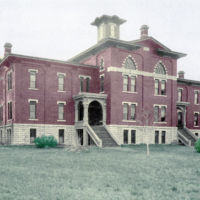
1887: Henry M. Mayo becomes the first graduate of Kansas Wesleyan.
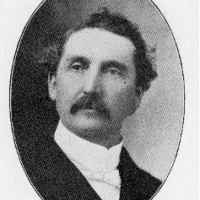
“It is the strength acquired by meeting the obstacles and overcoming them that makes us better and stronger men and women. It is the victory over those obstacles that gives us the courage for life’s best work.”
—Rev. H.M. Mayo, 1887 Graduation Speech
1890: Two student publications, the Wesleyan Lance and the Kansas Wesleyan Advocate, merge to form the Wesleyan Advance.
1891: C. W. Burch becomes the first graduate to complete all his work at Kansas Wesleyan. He went on to earn a legal degree and established one of the first Kansas law firms: Burch, Litowich, and Royce.
1904: Kansas Wesleyan opened its first residence hall, Schuyler Hall, named in honor of a much-loved university founder, Dr. Aaron Schuyler.
1908: Construction began on KWU’s second academic facility, Carnegie Science Hall. The science hall contained classrooms, laboratories, a museum, a telescope, and the university library.
1909: The University Methodist Church (known as the University United Methodist Church, UUMC) was organized to serve the university and south Salina, with services held in the KWU Administration Building until 1917 when the current church building was constructed adjacent to the campus.
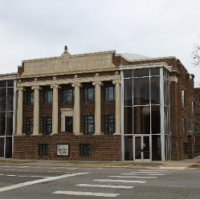
1911: Glenn Martin flew his self-built plane over southern Salina, near campus. Martin attended Kansas Wesleyan Business College but later moved to California, establishing several aircraft and aerospace companies.
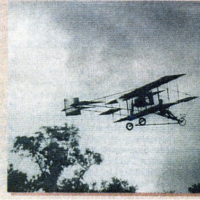
1916: King Gymnasium, Kansas Wesleyan’s first permanent athletic facility, opens. Named for Dean Albert King, a KWU professor, administrator, and supporter, the gym contained a swimming pool, basketball court, lockers, and other facilities. The face of the beloved clock which graced the gym, was salvaged after a fire destroyed the gym in 1987. The clock face is preserved in the Advancement Office in the Hall of the Pioneers.
1918: Kansas Wesleyan contributes to the First World War by conducting the “Student Army Training Corps.”
1921: The Administration Building is moved to a new campus location to make room for a new administration building, the Hall of the Pioneers (Pioneer Hall).
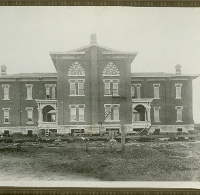
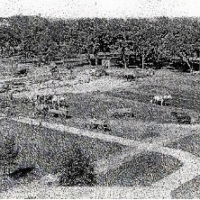
1922: Excavation begins on Pioneer Hall, but it is two more years before the cornerstone is laid. The building is not completed until 1930 although it is used in part starting in 1926.
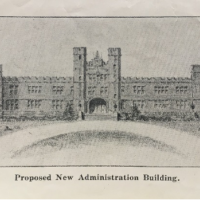
1928: The Grafton-Club mural “The Coming of the Pioneers” in Sams Chapel is dedicated.
1928: The KCAC is formed with KWU, Bethany College, Ottawa University, Baker University, McPherson College, and the University of St. Mary’s.
1928: Ruple Perkins of Athens, OH, a running back for the Coyotes, becomes the first African-American to play college football in Kansas. Despite discrimination by teams that refused to take the field with him, he earned All-KCAC First Team honors his freshman and sophomore years.
1930: Kansas Wesleyan University’s tuition, room and board total $400 a year.
1936: Marking its 50th anniversary, KWU had grown to 24 faculty members and a student body of 450.
1940: Glenn Martin Stadium is built with Works Progress Administration (WPA) labor, including KWU students. The football team wins the KCAC Championship.
“I studied Business Administration and played football for three years. We played the whole 60 minutes. The entire team was 20 players. We won the school’s first KCAC Championship in 1940. I also helped build Martin Stadium as a Works Project Administration project and got paid 25 cents an hour. Only three students on campus had a car back then.”—Bill Keeler ’44
1940: Kansas Wesleyan holds the inaugural Lilac Fete.
1948: Memorial Library is built and dedicated to the 24 students who died in World War II. Students help transport the books from Carnegie Science Hall to the new building using stretchers.
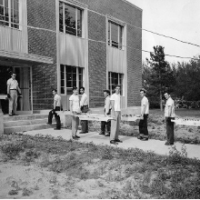
1958: KWU earns accreditation through the North Central Association, now called the Higher Learning Commission (HLC). The University continues this accreditation today.
“The women’s dorm, Pfeiffer Hall, had curfew hours. Miss Jean Bradley, the Housemother, stood inside the front door … and she locked it exactly at 10:30 p.m. or midnight! If you were to approach Pfeiffer Hall’s front door around 10:20 p.m. on weeknights — or 11:50 p.m. on Saturday — you would see a bevy of couples within 20 or 30 yards of the front entryway. Obviously, they would be shaking hands and bidding each other ‘Good Night.’” — Bob Pinkall ’58
1968: Enrollment hits a record 800 students. Many male students are shuttled to campus from rented barracks at the former Schilling Air Base because the campus residence halls are full.
1968: Women’s athletics, under the direction of Prof. Ginny Bevan ’56, begins with the formation of the Association of Kansas Women’s Intercollegiate Sports.
1969: A men’s dorm is opened. It was called “New Men’s Dorm” until the mid-1990s, when it was renamed Wesley Hall.
1978: KWU Kansas Delta chapter of Alpha Chi honor society is chartered.
1979: Muir Gymnasium is built.
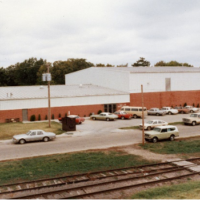
“I remember the games, the lectures, the connection to the University Church and many more things that made Kansas Wesleyan feel like home. My most embarrassing moment was when I blew up a microscope in Dr. Neuberger’s microbiology class. I went on to graduate in 1977 with a B.S., simultaneously with my R.N. diploma from Asbury Hospital School of Nursing.”
—Jerri Phillips ’77, ’92, ’07
1986: The KWU Athletics Hall of Fame is launched with 100 inductees to celebrate KWU’s 100th anniversary.
1988: KWU acquires the Asbury nursing program, located at Asbury-Salina Regional Medical Center. In 1994, the program moved to campus.
“When I arrived at Kansas Wesleyan in 1980, I was an inner city kid from Newark, NJ, coming from a single-parent household. I was the first one in my family to attend college. I remember Homecoming, Lilac Fete, the Christmas concerts and dinner at a professor’s house for those who couldn’t go home for Thanksgiving. I learned not only how to live alone but also how to live a life at Wesleyan.”—John Brooks ’84
1994: MBA program is launched; fiber optic cable is run to most of the buildings on campus.
“Being in choir was the greatest joy for me at KWU, and choir tour was one of my favorite experiences. The musical performances were fun, but the bus trip and traveling with my friends was the best.”—Amanda (Montgomery) Gutierrez ’92
2006: The first Project HERO (Helping Everyone Reach Out) day, the brainchild of two seniors, is organized by the Student Activity Board, and continues annually giving KWU students an opportunity to give back to the local community through community service projects.
2008: The Student Activities Center opens and includes the Hauptli Student Center, Brown Mezzanine, Mabee Arena, Muir Gymnasium, The Den and Yotee’s Spirit Store.
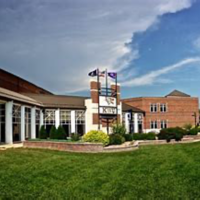
2010: Communication students launch the first Internet radio broadcast of KKWU.
2011: The Albert Nelson Student Success Center opens in Memorial Library.
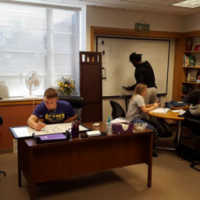
2014: Demolition begins on Glenn Martin Stadium to make way for the Graves Family Sports Complex.
2015: $1.2 million of technology upgrades expand Wi-Fi and fund the installation of new fiber cable in every campus building.
2015: The Graves Family Sports Complex stadium opens Oct. 3 to a then-record crowd of 2,011; legendary coach Gene Bissell helped cut the ribbon as the new Gene Bissell Field was dedicated.
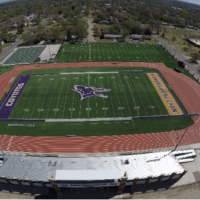
2016: Three fully online degrees are launched: Bachelor’s degrees in Criminal Justice and Emergency Management and a Master’s degree in Business Administration.
2021: The $5 million Nursing Education Center opens.
2024: Coyote Village, the university’s first new student housing in 60 years, joins Bieber Hall (the new entrance to Sams Chapel) and Bieber Dining Hall, housing a renovated Shriwise Café, in opening. KWU also christens two new Criminal Justice labs (the Jack Wilson Forensic CSI Lab and the Jack Wilson Experiential Learning Center) and wins its third straight KCAC Commissioner’s Cup, solidifying its status as one of the top small college athletic programs in the region. Finally, the university surpasses the 1,000-student mark for the first time, completing an astonishing rise of more than 40% growth in five years.
Historic Campus Buildings
- Lockwood Hall(1886—1959)
The first building on campus, Lockwood Hall, was completed on September 15, 1886 allowing Kansas Wesleyan to open its doors for the first time. The city of Salina donated 15 acres and $26,000 while the rest of the money for the project was secured through donations. The initial three story structure contained class rooms, laboratories, a chapel, a museum, a hall for literary societies and the president’s room. In 1921, the building was relocated at a cost of $40,000 to make room for the new administration building. On June 6, 1922 a service of dedication was held in memory of Rev. J.H. Lockwood, pioneer founder of KWU and on its first board of trustees, and the building was renamed in his honor. The building was used for Liberal Arts until construction was completed for Pioneer Hall. Lockwood Hall then housed the Division of Music and Art until it was demolished in 1959.
- KW Business College (1892—1935)
- Schuyler Hall (1904—1966)
In 1904 construction began on a women’s residence hall estimated to cost around $12,000. Every aspect of the project, including labor and materials, was associated with a donor. In September of 2004, students began to move in to the building even though only two of the four floors were completed. At its completion, Schuyler Hall contained 50 large student rooms, a dining room with accommodation for 200 and reception and library rooms. The total cost of the project, including surrounding infrastructure, totaled $17,000. The new women’s residence hall was dedicated in honor of Dr. Aaron Schuyler, the university’s second president. The dining hall was dedicated in honor of Mr. F.D. Kimble, a generous donor.
- Carnegie Science Hall (1908 — 1979)
The construction of this much needed science hall was made possible by the conditional gift of Mr. Andrew Carnegie in the amount of $25,000. He stipulated that an equal amount must be raised by Kansas Wesleyan and all outstanding deficits were to be cleared. The cornerstone was laid on November 15, 1908. The three story brick structure was surmounted by an observatory dome that housed a 12 inch reflecting telescope. The first and second floors of the building contained four large recitation rooms, lab and apparatus rooms and teachers offices. The third floor was temporarily revised for the university’s library and museum. The building stood strong until 1979.
- King Gymnasium (1916—1987)
A ground breaking ceremony was held on October 15, 1914 for the new gym on campus. The construction was made possible largely due to the efforts of Dean King and a group of his professional associates. The group was able to secure $14,000 in cash and pledges for the project. After numerous delays the cornerstone was laid on October 2, 1915. The building was completed and dedicated to King in 1916. The estimated value of the building was $35,000 without equipment and was considered by many to be among the finest athletics structures in the state of Kansas at the time. The structure stood proudly until 1987, when it was razed due to structural damage stemming from a fire in 1979.
- TW Roach President’s House (1909—1966)
- Pioneer Hall & Sams Chapel (1922—present)
Construction for the new administration building, officially known as the Hall of the Pioneers, began in 1921 after the original administration building was moved to the southwest corner of campus. Much of the framework for the new building was completed by 1923. On March 29, 1924, the cornerstone laying ceremony took place with the deposit of a time capsule. Members of the community grew frustrated by the lengthy construction project, so a campaign was launched by local professionals with the goal of raising $50,000. Thanks to a generous donation of $25,000 by E.C. Sams, the president and chairman of the board of J.C. Penney, the $50,000 was raised by 1925. On May 30, 1926 Sams Chapel was dedicated in honor of E.C. Sams’ parents. The project was finished in late 1929, allowing for spring classes to take place in the building during 1930. The dedication and celebration of the completed Hall of the Pioneers, for all of the pioneers who gave their time and funds to maintain the university, took place on September 14, 1930.
- JW Bean Memorial Wishing Well (1928—present)
- Glenn Martin Stadium(1940—2014)
Glenn L. Martin Stadium served as the home field for Kansas Wesleyan University from its official name dedication in 1940 to its demolition in early 2014 to make way for the new Sports Complex. The old stadium was one of many Works Projects Administration (WPA) projects in Kansas.
Martin Stadium was under lights with night games starting in 1983 and ending in October 2006. The stadium and well-used field were also to Sacred Heart High School Football beginning in 1978 and continuing through fall 2013.
Glenn Martin 1933 Visit for KWU Honor – Salina Journal
Glenn Martin 1940 Advance Story
Glenn Martin Biography and Obituary
- Memorial Library(1947—present)
Prior to 1948, the Kansas Wesleyan library was housed in Carnegie Hall. The cornerstone for Memorial Library was laid in 1948, and the building was dedicated to all Kansas Wesleyan students and families that lost their lives during World War II. Today, the library is home to over 60,000 book volumes, over 9,500 journals and magazines, hundreds of DVDs and tens of thousands of electronic books and magazines.
- Pfeiffer Hall (1951—present)
- Sams Hall of Fine Arts (1952—present)
- South Hall Apartments (1957—present)
- North Hall Apartments (1958—present)
- Highland House (1966—present)
- Greek Hall (1966—1969)
- Independence Hall (1966—1969)
- Frederick Conrad Peters Science Hall (1969—present)
- Fieldhouse (1969—2013)
- Wesley Hall (1969—present)
- Muir Gymnasium (1979—present)
- Hauptli Student Activity Center (2006—present)
- Mabee Arena (2006—present)

